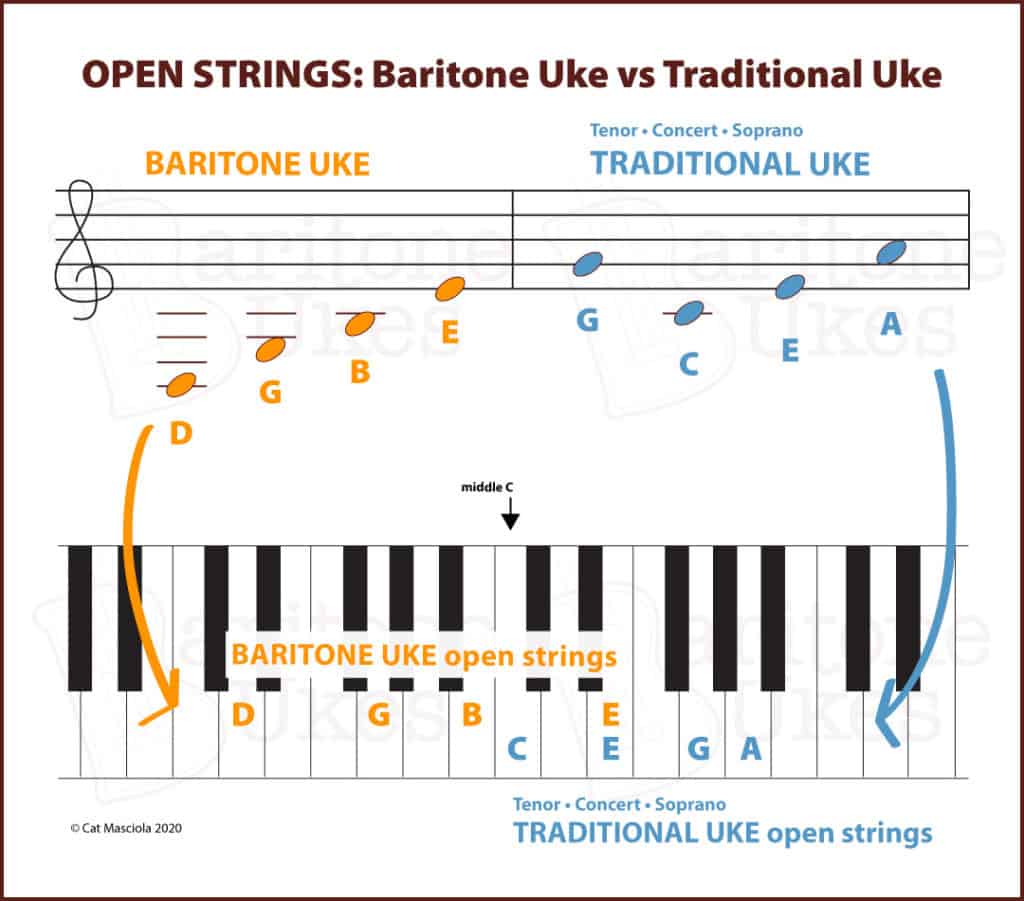Baritone ukulele chords are the same as guitar chords, similar to traditional ukulele chords, and different from other stringed instruments:
- Baritone uke chords are the same as guitar chords—just using the four higher-pitch strings instead of all six.
- Baritone uke chords are similar to traditional Hawaiian ukes (tenor, concert, soprano)—the shapes are the same but the notes are higher in pitch.
- Baritone uke chords are similar to baritone guitar chords—the chord shapes you learn on baritone ukulele will work on the four higher pitch strings of the baritone guitar, but you’ll be playing in a different key.
- Baritone uke chords are different from tenor guitars with standard tuning, but the same as tenor guitars using a D-G-B-E string set.
- Baritone uke chords are different from bass ukulele—different notes, different intervals, different pitch.
- Baritone uke chords are different from other stringed instruments like mandolin and banjo: different notes, different intervals, different pitch.
Are Baritone Ukulele Chords Different from Guitar Chords?
The only difference between baritone ukulele chords and guitar chords is that the baritone uke is “missing” the guitar’s two lowest-pitch strings. Baritone ukulele chord shapes and chord names are the same as guitar. The intervals between strings are the same, the notes are the same. (Interval just means the number of notes, or half-steps, between one string and another.)
That’s why baritone ukulele sounds more like a guitar than other ukuleles. And that’s why baritone uke can take the place of guitar when you’re playing with a combo like bass and drums. The bass player provides those lowest notes that aren’t available on baritone uke.
| Guitar – low to high | Baritone Uke – low to high |
| low E | n/a |
| low A | n/a |
| low D | same |
| G | same |
| B | same |
| E | same |
If you’ve tried to learn guitar but found it too difficult or time consuming, then everything you’ve already learned applies directly to baritone ukulele. Cool!
Baritone ukulele is hands-down the best instrument for would-be guitarists
You can play the same songs in the same keys with the same chords as guitarists. You can quickly learn to strum “guitar” chords and jam with your friends, taking the role of the rhythm guitarist in the band.
If you want a simplified guitar, get a baritone uke. You’ll be thrilled.
Are Baritone Ukulele Chords Different from Other Ukuleles?
Baritone ukulele chords are different from traditional Hawaiian ukuleles. The chord shapes are the same as tenor, concert, soprano ukulele chord shapes, but the notes are in a different key. So the chord names are different and they sound higher in pitch.
The intervals between the notes are the same, which means that a major chord shape will always form a major chord on any size ukulele. But the notes you’re playing are in a higher key on traditional Hawaiian ukes (tenor, concert, soprano).
What this means is that you can play the same songs with the same chord shapes on both baritone ukes and traditional ukes, but you’ll be playing in a different key.

Baritone uke is five half-steps lower than traditional uke, which makes a BIG difference to singers. So you can play the same songs with the same chords, but the melody will be in a different area of your voice pitch.
If a song is too high for your voice on a tenor uke, you can try playing the same song with the same shapes on a baritone uke, making the melody five half-steps lower.
Re-entrant versus linear tuning
Another important difference between baritone ukulele and traditional Hawaiian ukuleles is the range. Instead of the lowest notes that are available on a baritone uke’s thickest string—the lowest-pitch string (closest to your head)—the traditional Hawaiian uke instead uses a thinner string that is tuned an octave higher, creating the tight harmonies and jangling island sound that is the signature sound of traditional ukuleles.
This string arrangement is called re-entrant because you start with a high note string, then drop to a lower note on the next string, and then continue up in pitch with the next two strings. Compare this to guitar and baritone ukulele: the strings go from low to high in a line, which is called linear tuning.
Consequently, baritone uke has almost a full octave more range in the lower notes, giving you that guitar-like sound instead of the higher island sound with the tight harmonies that you get with a traditional uke.
| Guitar standard tuning | Baritone Uke standard | Traditional Uke (tenor, concert, etc) |
| low E | none | none |
| low A | none | none |
| low D | same as guitar | high G |
| G | same as guitar | C |
| B | same as guitar | E |
| E | same as guitar | A |
If you want the island sound, get a traditional Hawaiian uke (tenor, concert, soprano). If you want a simplified guitar, get a baritone uke.
Related Posts
I spent weeks researching the most common chords that I’d need to play songs, so I could start jamming with friends fast. Then I spent about 40 hours making the perfect one-page chord chart that I could stuff in a pocket and take anywhere. Check it out and get the free printable chart: Beginner Chords for Baritone Ukulele: Which to Learn First.
Are Baritone Ukulele Chords Different from Baritone Guitars?
Baritone ukulele chords are similar to baritone guitar chords, but not the same. Once again, the chord shapes for a baritone ukulele are quite similar, but the key is different. This occurs because the intervals between the strings are the same.
While there are several common tunings for baritone guitar—the lowest note might be B, A, or C—the intervals between the strings are the same as regular guitars, and ukuleles, which means that the chord shapes and the scale patterns are familiar to guitarists and uke players.
The baritone guitar has six strings, however, and the baritone uke just four. But if you compare four highest pitch strings of the baritone guitar to the baritone ukulele, you’ll find that the chord shapes and scale patterns are the same, but the key is different.
Are Baritone Ukulele Chords Different from Tenor Guitars?
Baritone ukulele chords are different from standard tuning on a tenor guitar, so if you pick up a tenor guitar in a music store, it may be unfamiliar to what guitarists and uke players are used to. But tenor guitar is often tuned like the standard guitar’s four higher-pitch strings, i.e. the same tuning as a baritone ukulele. So you might pick up a tenor guitar and find that the strings, notes, and chords match your baritone uke exactly.
Baritone ukulele players who want to experiment with steel strings and a bigger body can try a tenor guitar with D-G-B-E tuning. Banjo players who want to double on guitar with ease can tune the tenor guitar to match the 4-string banjo (ignoring the 5th short string on the banjo).
Are Baritone Ukulele Chords Different from Bass Ukuleles?
Baritone ukulele chords are different from bass ukuleles. While the baritone ukulele’s strings match the four higher-pitch strings of the guitar, the bass ukuleles match the four lower-pitch strings of the guitar, and drop one octave. Like this:
| Guitar tuning | Baritone ukulele tuning | Bass guitar and bass ukulele tuning | Tenor ukulele tuning (and concert, soprano) |
| E2 | none | E1, one octave below guitar | none |
| A2 | none | A1, one octave below guitar | none |
| D3 | same as guitar | D2, one octave below guitar | G4, “high G” |
| G3 | same as guitar | G2, one octave below guitar | C4 |
| B3 | same as guitar | none | E4 |
| E4 | same as guitar | none | A4 |
For intermediate musicians: the next chart shows the intervals between strings on a guitar, baritone uke, tenor uke, and bass guitar or bass ukulele. When the intervals are the same, the chord shapes and scale patterns will be the same, although the pitch may be different.
| Guitar intervals between strings | Baritone uke intervals between strings | Bass uke/guitar intervals between strings | Tenor uke intervals between strings |
| E2 to A2, perfect 4th | none | same as guitar | none |
| A2 to D3, perfect 4th | none | same as guitar | none |
| D3 to G3, perfect 4th | same as guitar | same as guitar | same as guitar +1 octave |
| G3 to B3, major 3rd | same as guitar | none | same as guitar |
| B3 to E4m perfect 4th | same as guitar | none | same as guitar |
Are Bass Ukuleles Different from Bass Guitars?
Bass guitars and bass ukuleles have the same notes, intervals, pitches, and chords, as do upright basses. So you can play the same notes, same scales, and same songs on both instruments without learning any new patterns. (Chords are rarely used on a bass. A bass is played one note at time, because the notes are so low in pitch that a chord would sound too muddy to be clearly discernible to human hearing.)
Luna brand makes a bass ukulele that is tuned the same as as a bass guitar but one octave higher, making it exactly the same as the lowest four strings of a regular guitar.
Here an excellent short video by Stephen Cox that demonstrates and compares bass ukulele with bass guitar: https://www.youtube.com/watch?v=M-jkvT0VLgY
Are Baritone Ukulele Chords Different from Mandolin?
Baritone ukulele chords are quite different from mandolins. The intervals between strings on a mandolin are perfect fifths, whereas baritone ukulele intervals are perfect fourths and a major third. Plus the pitches are different. So making the switch from one to the other is pretty much like learning a new instrument.
Violins and Violas
Violins and violas are tuned in intervals of perfect fifths, like mandolins. So they are quite different from ukes and guitar of all types, except for tenor guitars which are sometimes tuned in perfect fifths.
Are Baritone Ukulele Chords Different from Banjos?
Banjos are commonly tuned in several different ways, all of which are different from guitars and ukes. The notes, chords, and scales are different because the intervals between strings are different.
Are Baritone Ukulele Chords Different from Banjoleles?
No, they are the same. Banjoleles are essentially the same instrument as other ukuleles, just made with different materials and a different shape. Baritone banjoleles are the same as baritone ukuleles, tenor banjoleles are the same as tenor ukuleles, and so on.
In Summary
Instruments that have a lot in common with baritone ukuleles include all types of guitars such as traditional guitar, tenor guitar, baritone guitar and bass guitar, as well as upright bass, and all types of ukuleles.
Other striged instruments like n mandolins, banjos, fiddles, violins, and violins are quite different in the tuning, the intervals between strings, the notes, chords, and scale patterns.



You are freakin’ AWESOME!
🙂